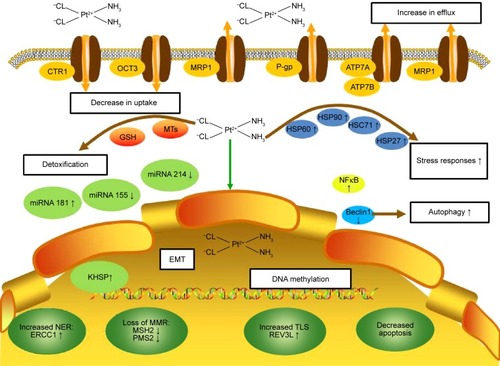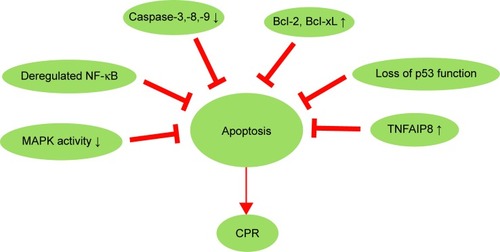Figures & data
Figure 1 Molecular mechanisms of CPR in cervical cancer.
Notes: The molecular mechanisms underlying cisplatin resistance in cervical cancer are complex and associated with the following features: 1) reduction in the intracellular accumulation of the platinum compounds (decrease in uptake, increase in efflux, and increased drug detoxification by cellular thiols); 2) increase in DNA damage repair (increased NER, loss of MMR, and increased TLS); 3) inactivation of apoptosis; 4) activation of EMT; 5) alteration in DNA methylation, microRNA profile, cancer stem cell characteristics, and expression of stress-response chaperones.
Abbreviations: CPR, cisplatin resistance; CTR1, copper transporter 1; EMT, epithelial–mesenchymal transition; ERCC1, excision repair cross-complementing; GSH, glutathione; HSC71, heat-shock cognate protein 71; HSP, heat-shock protein; MMR, mismatch repair; MRP1, multidrug resistance protein 1; MSH2, MutS homolog 2; MTs, metallothioneins; NER, nucleotide excision repair; NF-κB, nuclear factor-κB; OCT3, organic cation transporter 3; P-gp, P-glycoprotein; PMS2, post-meiotic segregation 2; TLS, translesion synthesis.
Abbreviations: CPR, cisplatin resistance; CTR1, copper transporter 1; EMT, epithelial–mesenchymal transition; ERCC1, excision repair cross-complementing; GSH, glutathione; HSC71, heat-shock cognate protein 71; HSP, heat-shock protein; MMR, mismatch repair; MRP1, multidrug resistance protein 1; MSH2, MutS homolog 2; MTs, metallothioneins; NER, nucleotide excision repair; NF-κB, nuclear factor-κB; OCT3, organic cation transporter 3; P-gp, P-glycoprotein; PMS2, post-meiotic segregation 2; TLS, translesion synthesis.

Figure 2 Inactivation of apoptosis pathway and CPR in cervical cancer.
Note: Multiple molecules and signaling pathways that inhibit apoptosis can lead to CPR.
Abbreviations: CPR, cisplatin resistance; MAPK, mitogen-activated protein kinases; NF-κB, nuclear factor-κB; TNFAIP8, tumor-necrosis-factor-α-induced protein 8.
Abbreviations: CPR, cisplatin resistance; MAPK, mitogen-activated protein kinases; NF-κB, nuclear factor-κB; TNFAIP8, tumor-necrosis-factor-α-induced protein 8.

Table 1 Agents to overcome CPR in cervical cancer
